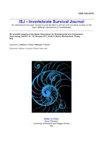Expression profiles of immune-related genes in coelomocytes during regeneration after evisceration in Apostichopus japonicus
IF 1.2
4区 农林科学
Q4 IMMUNOLOGY
引用次数: 2
Abstract
A representative echinoderm, the sea cucumber Apostichopus japonicus has a special regeneration mechanism. The sea cucumber has no specific immune tissues or organs. Coelomocytes of sea cucumbers are involved in their cellular and humoral immunity. In this study, expression profiles of the main immune-related factors in sea cucumber coelomocytes were detected during coelomocyte regeneration after evisceration in A. japonicus. Immune-related factors Cu/Zn superoxide dismutase (Cu/Zn SOD), Catalase (CAT), C-type lysozyme (C-LYZ), Cathepsin D (CTSD), Melanotransferrin (MTF), Toll-like receptor (TLR), C-type lectin (C-LCT), Complement 3 (C3), Myeloid differentiation factor 88 (MYD88), Nuclear factor kappa-B (NF-κB), NF-κB inhibitor (IKB), TNF receptor-associated factor 6 (TRAF6), Peroxiredoxins (PRX), Nitric oxide synthase(NOS), Caspase-2 (CASP-2), Phenoloxidase (PO), and Glutathione Peroxidase(GPX), Heat shock protein 70 (HSP70) were detected by real-time fluorescent quantitative PCR at different time points during regeneration. The main immune-related genes in sea cucumber coelomocytes were significantly differentially expressed after evisceration, and an upregulation was observed for the majority of the considered genes. In summary, the discharge of viscera had a significant effect on expression of immune-related genes of sea cucumber coelomocytes. The expression level of each gene had a certain correlation with the sea cucumber regeneration process. The results provide reference data for the immune response of coelomocytes during regeneration.刺参内脏再生过程中体腔细胞免疫相关基因的表达谱
刺参是棘皮动物的代表,具有特殊的再生机制。海参没有特定的免疫组织或器官。海参体腔细胞参与了海参的细胞免疫和体液免疫。在本研究中,我们检测了海参体外空腔细胞再生过程中主要免疫相关因子在海参空腔细胞中的表达谱。免疫相关因子铜锌超氧化物歧化酶(Cu/Zn SOD)、过氧化氢酶(CAT)、c型溶菌酶(C-LYZ)、组织蛋白酶D (CTSD)、黑素转铁蛋白(MTF)、toll样受体(TLR)、c型凝集素(C-LCT)、补体3 (C3)、髓样分化因子88 (MYD88)、核因子κ b (NF-κB)、NF-κB抑制剂(IKB)、TNF受体相关因子6 (TRAF6)、过氧化物氧化酶(PRX)、一氧化氮合酶(NOS)、Caspase-2 (CASP-2)、酚氧化酶(PO)、谷胱甘肽过氧化物酶(GPX);采用实时荧光定量PCR检测再生过程中不同时间点的热休克蛋白70 (HSP70)含量。海参空腔细胞中主要免疫相关基因在去内脏后表达显著差异,且大部分基因表达上调。综上所述,内脏排出对海参体腔细胞免疫相关基因的表达有显著影响。各基因的表达量与海参再生过程有一定的相关性。该结果为体腔细胞再生过程中的免疫应答提供了参考数据。
本文章由计算机程序翻译,如有差异,请以英文原文为准。
求助全文
约1分钟内获得全文
求助全文
来源期刊

ISJ-Invertebrate Survival Journal
IMMUNOLOGY-ZOOLOGY
CiteScore
2.10
自引率
0.00%
发文量
0
审稿时长
>12 weeks
期刊介绍:
Invertebrate Survival Journal (ISJ) is an international and open access journal devoted to prompt and innovative studies on the basic defense mechanisms in invertebrates, in particular with a view to identifying biotechnologies able to act against derived diseases and related economic damage.
Contributions will be mainly in the form of Letters to the Editor, Visions and Perspectives, Short Communications, Technical Reports, Research Reports, Review, Minireview and Reports of Meetings. Letters to the Editor can be commentaries or perspectives on invertebrate defence mechanisms or replies to the data published in ISJ.
 求助内容:
求助内容: 应助结果提醒方式:
应助结果提醒方式:


